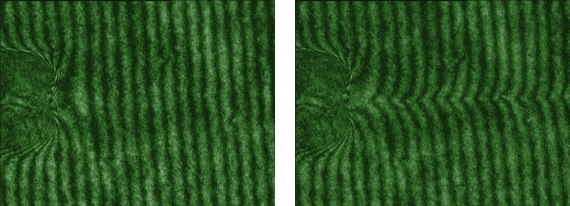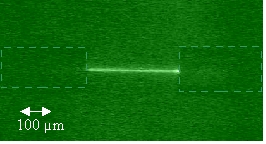Thin Films & Nanomaterials:
Photonics :
Our activity in photonics is focused on the development and characterization of optically heterogeneous environments with original properties in terms of light-matter interaction. Two aspects are privileged :
- Observation of some phenomena of linear and nonlinear propagation of laser beams, in particular the soliton propagation in nematic liquid crystals
- Development of methods to measure the relevant parameters (ie non-locality variations of photo-induced index, response time, stability ...). Conversely, the soliton propagation becomes a tool for investigation of new materials such as nano-particles dispersed in an anisotropic matrix
a – Recent results :
A few years ago, we highlighted a spatial soliton propagation in liquid crystals [ P1]. This type of propagation corresponds to a collimated beam, due to a self-focusing effect initiated by a molecular reorientation in the liquid crystal. We set up two measurement techniques for characterizing the propagation, one based on the use of Raman spectroscopy and the other on the guiding properties of optical solitons.
- Raman spectroscopy is used to quantify the nonlocal character of the index variation accompanying the molecular reorientation, the guarantee of stability for spatial solitons [P2]. Other studies conducted by interferometry came confirm this result (Figure 1)

|
| a |
b |
Figure 1 : Interferogram corresponding to the birth of a spatial soliton in liquid crystal
(a : without laser,
b : with laser beam propagates from left to right) : the deformation of the fringes reflects the non-local variation index in the liquid crystal |
- The stability of a soliton requires conditions on the non-locality that is necessary to control. In our systems based on liquid crystal, this non-locality is strongly linked to the intrinsic elasticity of these materials and any electric field applied. We played on these two parameters. On the one hand by changing the elasticity by the insertion of a low density of polymer within the liquid crystal [P3] and the other by applying a stabilizing voltage in the axis of the soliton [P4]. The latter approach has proved promising in terms of improved signal to noise ratio associated with the coupling between two optical fibers obtained via an optical soliton (Figure 2).
 |
|
Figure 2 : Optical coupling obtained by inducing a soliton between two conductive optical fibers (dotted), between which a stabilizing voltage (V = 4 volts) is applied (S / N = 8 dB) |
b – Present and future :
Soliton propagation is closely correlated to the material properties in which it spreads, we now explore the association LC / inorganic particles, to a complete understanding of these interactions between light and matter and potentially to development of innovative optical materials. Three tracks are used :
- Study and characterization of materials based on liquid crystal whose dielectric function is modified by dispersion of nanoparticles with ferroelectric properties.
- Study and characterization of materials based on liquid crystal whose refractive properties are modified by addition of metallic nanoparticles (the accordable index metamaterials).
- Research of phenomena of strong localization of light, linked to the insertion of diffusing particles with high index contrast within the liquid crystals.
Solitons are here used as minimally invasive probe of refractive and diffusive properties of the mixtures.
Publications :
- P1. Experimental study of the nonlocality of spatial optical solitons excited in nematic liquid cristal
J.F. Henninot, J.F. Blach, M. Warenghem
Journal of Optics A: Pure and Applied Optics 9 (2007) 20-25. - P2. Observation of spatial optical soliton launched in biased and bias free Polymer stabilized nematic
J.F. Blach, J.F. Henninot, M. Petit, A. Daoudi, M. Warenghem
Journal of the Optical Society of America B 24 (2007) 1122-29.
- P3. The investigation of an electrically stabilized optical spacial soliton induced in a nematic liquid crystal
J.F. Henninot, J.F. Blach, M. Warenghem
Journal of optics A : Pure and Applied Optics 10 (2008) 085104.
|






